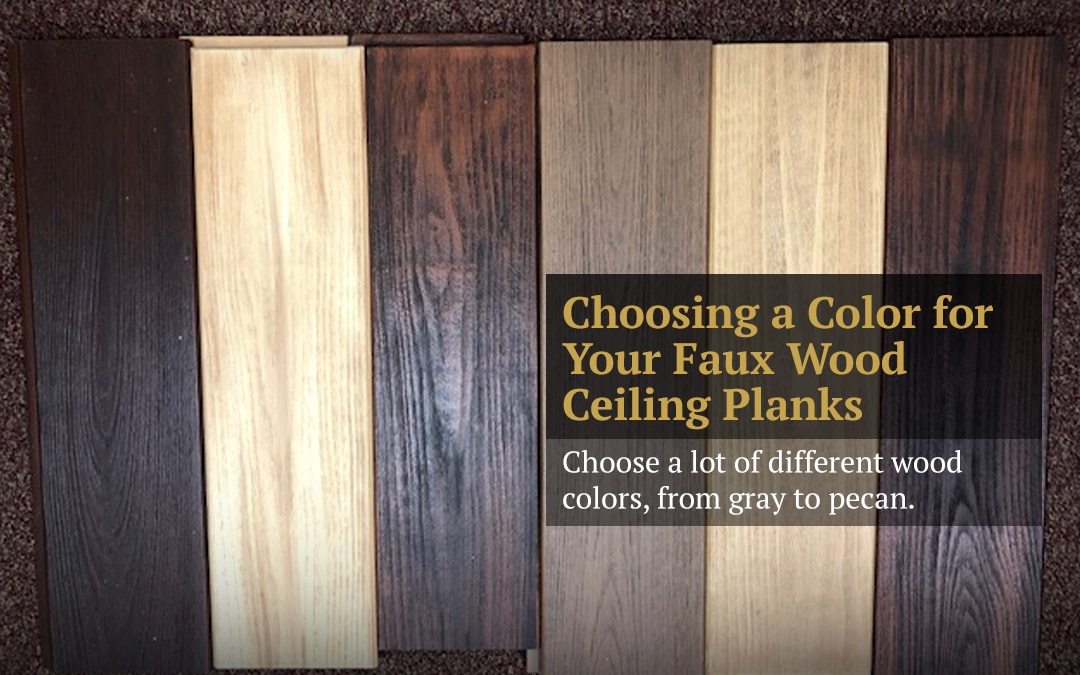Tags: Faux Tongue & Groove Ceiling Planks, Faux Tongue & Groove styles, Faux Wood Beams, Faux Wood Ceiling Beams, Tongue & Groove Faux Wood Planks
Do you want to transform your home or office into a cozy space with oodles of character? One of the best ways to do this is by installing premium-quality faux wood planks on a statement ceiling.
Accent ceilings are an excellent way to cover up outdated surfaces. Think mid-1990 popcorn ceilings. And even if you don’t need to disguise old-fashionedctextures, you can still breathe new life into your home with wood plank accents.
But what faux wood color choices are available? And how do you select the right look for your home’s specific needs? Let’s dive into how to choose the color of your wood ceiling for maximum impact and esthetic value.
Where Should You Put Faux Wood Ceilings?
Let’s get one thing straight. Ceilings are among the most neglected parts of a house or office. Yet, they also represent prime real estate when it comes to tying together the decor theme of a room or property.
There’s no better way to incorporate some rustic wood elements into your space, whether it’s a dining room, living room, or the reception area of your office. Whether you’re after an airy, clean Scandinavian vibe or a dramatic, formal ceiling in dark wood, options abound.
Ceiling beams add dimension and texture to living spaces. They can inspire a feeling of a bygone era when rough-sawn and hand-hewn beams were standard features of 18th and 19th-century architecture. Or they can appear minimalistic, clean, and highly contemporary.
Best of all, installing planked wood ceilings is a reasonable DIY project that’ll leave you feeling proud and impressed by the finished product.
How to Choose Wood Colors for a Statement Ceiling
Where should you start when it comes to settling on the best faux wood plank colors for your living or working space? Begin by taking a careful look at your current decor.
What do you love and hate about this space? What works, and what doesn’t? No matter which direction you’d like to head or what you’d like to keep or get rid of, make sure that you clearly and thoroughly define your esthetic objectives before getting started.
As you design the space you’re after, here are some questions you need to ask yourself. Do you want to celebrate light pine or gray colors in the area you’re decorating? Do you prefer deeper, darker colors such as cherry, mahogany, or rich oak planking?
Here are a couple of tips to keep in mind as you make decisions. For starters, lighter-colored faux wooden panels accompany white, gray, and pastel color schemes elegantly. When you go this route, you’ll imbue the area with an airy, spacious vibe.
If you’re looking for a more formal or dramatic appearance, consider complimenting jewel tones and gold accents with dark ceilings. Once you’ve decided whether light or dark faux wood planking is right for you, it’s time to narrow down your options further.
Other Esthetic Considerations to Bear in Mind
What if you don’t find a color of faux wood planking that you love? Consider finishing or painting it yourself. Of course, you’ll need to do this before you mount it on the wall.
If you have a precise color in mind or want to match other wooden features already present in your home, this approach remains your best option. When selecting your paint or stain color, consider whether you want to go with contrasting or complementary hues.
Along with color, you’ll also want to consider other factors, such as the texture of your wooden planking. Do you prefer smoother planking or a heavily distressed look?
Do you long for a more dimensional look? Or, do you want your planking to match the color of a modern ceiling? Are dramatic contrasts in order?
These are all issues you must consider before making a final decision.
Determine How Many Faux Wood Planks You’ll Need
How do you decide which faux wood colors are right for your space? Start by measuring the width and length of your ceiling accent space. Then, multiply these two numbers to get the square feet of wood planking you’ll need.
For irregularly shaped rooms, break the space down into smaller rectangles. Calculate the square footage of each section and then add these figures together.
Remember that ceiling planks come in sections that are ten feet long by four feet wide. Of course, you’ll need to trim some of these wood planks to fit your space. But you want to purchase the minimum amount possible to stay within budget while still covering your accent area properly.
Create and Stay Within a Budget
Once you know how much material you’ll need, you can shop faux wood planks being careful to stay within your budget. Of course, that also means allocating a specific budget for your project.
As you create an outline of how much you want to spend, be sure to factor in these standard supplies:
- Measuring tape
- Hammer
- Wood to make support beams
- Framing square
- Tapping block
- Nail gun and nails
- Power saw, such as a chop or miter saw
- Faux wood plank material
- Hole saw
How can you cut costs when it comes to these supplies? Inquire at your local hardware store about renting power tools.
Revolutionize Your Home or Office With Wood Ceiling Planks
Few features stand to up the wow factor in your home or office as much as premium-quality faux wood plank accents on your ceiling. Whether you wish to create a rustic look with dark wood accents or keep things light and airy with light-colored, Scandinavian-inspired planks, you’ve got plenty of options.
Ready to find the perfect color for your space? Shop faux wood ceiling planks now.

